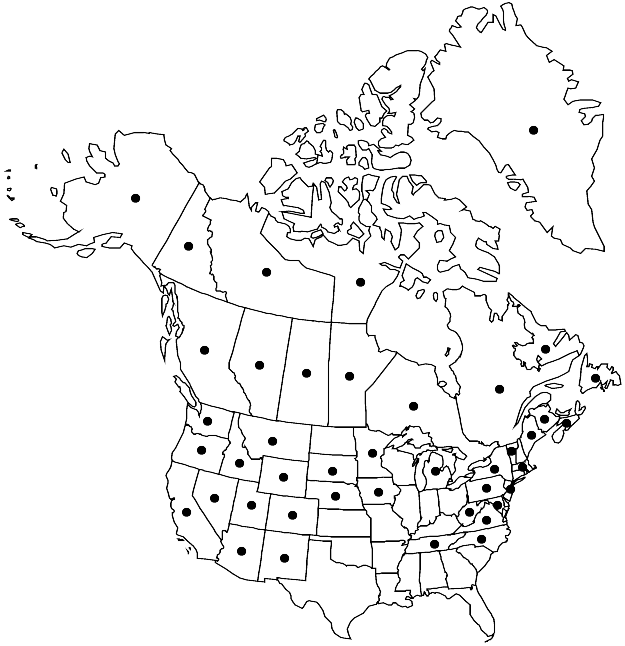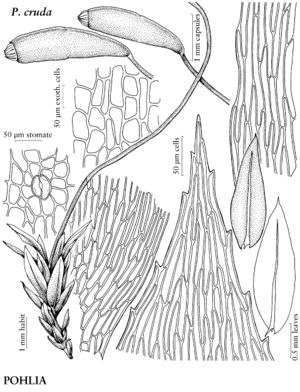Pohlia cruda
Musc. Scand., 18. 1879.
Plants medium-sized to large, green, whitish, or sometimes bluish tinged, shiny. Stems 0.5–2.5 cm. Leaves erect to ± spreading, lanceolate to elliptic, 0.8–2 mm; margins serrulate to serrate in distal 1/3; costa subpercurrent; distal medial laminal cells linear-rhomboidal, vermicular, firm, 70–140 µm, walls thin. Specialized asexual reproduction absent. Sexual condition paroicous, rarely dioicous; perigonial leaves in dioicous plants linear- or long-lanceolate from ovate base; perichaetial leaves strongly or rarely weakly differentiated, linear-lanceolate. Seta orange to orange-brown. Capsule inclined 10–135°, stramineous to orange-brown, long- and slender-pyriform, neck 1/2 urn length; exothecial cells elongate-rectangular, walls straight; stomata superficial; annulus present; operculum conic; exostome teeth yellow-brown to red-brown, acute-triangular; endostome hyaline, basal membrane 1/2 exostome length, segments broadly keeled, broadly perforate, cilia short to long. Spores 18–26 µm, ± coarsely papillose.
Phenology: Capsules mature summer (Jun–Aug).
Habitat: Soil banks, rock crevices, under roots, tundra soil and paths
Elevation: moderate to high elevations
Distribution

Greenland, Alta., B.C., Man., N.B., Nfld. and Labr., N.W.T., N.S., Nunavut, Ont., Que., Sask., Yukon, Alaska, Ariz., Calif., Colo., Idaho, Iowa, Maine, Md., Mass., Mich., Minn., Mont., Nebr., Nev., N.J., N.Mex., N.Y., N.C., Oreg., Pa., S.Dak., Tenn., Utah, Vt., Va., Wash., W.Va., Wyo., Mexico, South America, Eurasia, Pacific Islands, Australia, Antarctica.
Discussion
Pohlia cruda is distinguished by the glossy, pale green to whitish or bluish leaves that are narrowly elliptic to lanceolate; the laminal cells are long and narrowly linear-vermicular; the perichaetial leaves are strongly differentiated and linear-lanceolate; the sporophytes have necks about as long as the urn, with long-tapered exostome teeth, broadly keeled and perforate segments, and short to long cilia. Along with P. nutans, P. cruda is one of the most common North American species of the genus. Unlike P. nutans, P. cruda is restricted to northern and montane sites where it grows in rock crevices and on soil banks. The leaves of this species are sometimes slightly complanate. The gametophytes can be unisexual (dioicous) or bisexual (paroicous).
Selected References
None.
